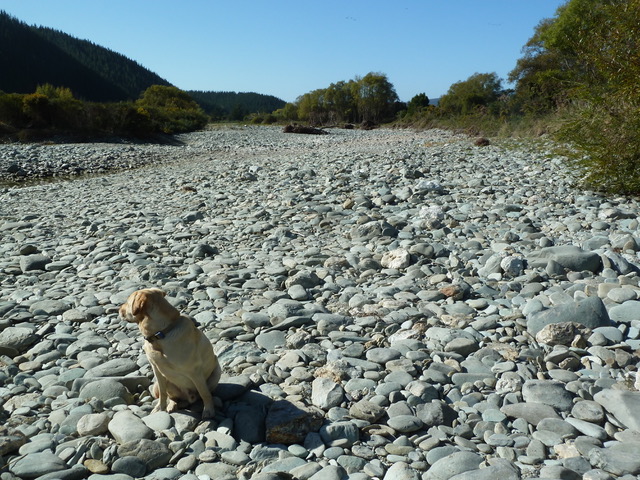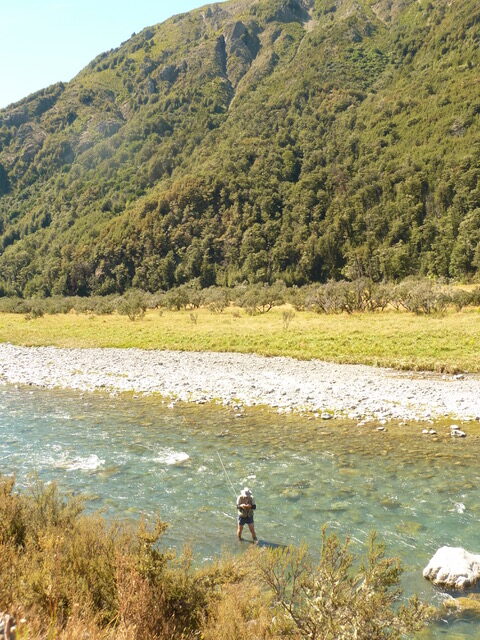by Tony Orman



The decline in New Zealand’s trout and salmon fishing has hit the headlines in recent years particularly as regards the Rakaia River issue and Environment Canterbury’s negligence. Here’s an article I wrote in 2016 about a Canadian couple, both keen fly fishers and very perceptive about the decline then. It’s timely to recall the warning then – almost a decade ago – and to analyse how little has been done since to stem the decline despite NZFFA’s efforts
A Canadian husband and wife fly fishers who regularly visit New Zealand to fish have broken their silence to tell Kiwis to wake up to the accelerating habitat destruction and decline in New Zealand’s trout fisheries.
Dave and Amelia Jensen, a couple of fly fishers from Alberta, Canada expressed initial reluctance to speak out on the visible decline.
“For far too many years, Amelia and I have been silent on what we have been seeing as we’d rather focus on the positive, the wonderful fly fishing the South Island has to offer,” said Dave.
But with the decline accelerating, the couple now want to speak out.
The reality was that every year the past five years, four or five small tributary streams have been lost to the agriculture industry. The destruction was simply wreaking havoc on both the west and east sides of the South Island.
“Like it or not, there are severe issues throughout New Zealand,” he said. “As my wife and I have walked over 1000km per year of the tiniest of tributaries throughout the entire Canterbury Region the past decade, we see so many grave issues that the future of trout through the region is in serious peril.”
Dave Jensen questioned whether installing a regulation limiting winter fishing on Canterbury rivers as was recently done, was addressing the real cause of the threat.
“Anglers want to know that managers aren’t simply casting aim at anglers when the extreme habitat issues are far and away the main culprit. Centuries of agriculture with the more recent demands of intensive livestock use for new and varied uses and markets simply aren’t sustainable.”

A once fine trout stream in Marlborough that now runs dry in summer due to pine monocultures sucking up water.
Anglers not responsible
New Zealand’s fisheries in some regions, with habitat changes and alterations occurring as quickly as was occurring, were rapidly deteriorating. Anglers were not remotely the main cause of trout stock depletion – It was declining suitable habitat. However where anglers were was is in collective apathy in allowing extreme habitat change to occur and perpetuate.
Speaking on the concept of closing waters to winter angling, Dave and Amelia said that put the “blame” or responsibility on anglers.
“I assure anglers are not the main reason the trout populations are crashing.”
The couple said annually waters were lost to the agriculture industry through dredging, straightening flows, dumping piles of shingle as bank stabilization which was eroded and filled the course with sedimentation, ripping out stream flows and temperature-regulating willow and bush canopies thereby opening the stream to direct sunlight and rapid thermal heating, creation of gravel traps with little monitoring or regulation of operations; and literally moving spring creeks hundreds of metres from their original location.
Stream “nuked’
Dave Jensen said a small stream near Hanmer Springs was “absolutely nuked” by the land owner with Environment Canterbury’s blessing. Once a fine brown trout stream, it now had been straightened, many willows removed, sedimentation rife and so little water of any depth now existed.
“This is but one example of an alarmingly long list of streams in the region. Indeed the issue is the entire length of the island. You simply cannot continue to destroy key parts of the life stage habitat requirements of trout and not impact carrying capacity.”
The rate of increase of numbers of pumps sucking water out at an unprecedented rate, even in extreme droughts as was experienced October to December, 2015 was shocking.
As to farming, Dave and Amelia said farmers wanted dams and irrigation canals.
“But, what if they had left their lands with some riparian areas and worked within the boundaries of what the land itself is capable of producing? Much like water has a carrying capacity for trout, a land base naturally has a carrying capacity for growth. It’s patently obvious where the long term is headed in both cases of water and land on the South Island,” said Dave.

“The public should not be deluded by any quality fishing in the high country. Even those
that only fished the wonderful beech forested, back country waters, needed to pay attention. “
Serious Trouble
It was wrong to blame anglers for the loss of habitat that was driving trout out of those waters. The South Island was in serious trouble.
Dave Jensen said the public should not be deluded by any quality fishing in the high country. Even those that only fished the wonderful beech forested, back country waters, needed to pay attention.
“You simply cannot ignore the connectedness of the high country trout and low country trout – don’t be fooled by your mouse influenced, trophy beech forest trout. These same fish are connected to the lowland stocks.”
With the movement between various waters and to the sea, all habitat has to be considered critical.
Writing on Wall
“When many of the lowland rivers are devoid of fish sometime this decade, do you not think that the migrating fish numbers to the mountain waters, will not also dwindle? And when the lowland waters are trout free, do you not think the angling pressures on those back country waters will increase? The writing on the wall in front of you. Blaming anglers is not the way.”
There are a vast array of tools fisheries managers could use but when the agriculture industry continued to pound away at habitat, it was an endless losing battle and certainly disheartening for management.
A change in mindset needed to occur not only in the agriculture industry, but also in the trout fisheries community. Closures would be ineffective without stopping the habitat deterioration. Anglers needed to stand up and be counted in the fight to stop the destruction. Apathy and silence would not win.

Back in 2000, a North Canterbury Fish and Game environmental officer Wayne McCallum warned of the
crisis about declining lowland fisheries

Back in 2020, a report said behind New Zealand’s clean and green image is a dirty truth — its freshwater rivers are among the most polluted in the developed world. Last year, a government report found nearly 60 per cent of the country’s rivers carry pollution above acceptable levels, with 95 to 99 per cent of rivers in pastoral, urban and non-native forested areas contaminated.
The Jacinda Ardern government did zilch. They sat on their hands.
Not that National-ACT-NZ First are better, far from it, with pro-exploiters Shane Jones and Chris Bishop in the driver’s seat.
Many of our rivers, lakes, and groundwaters have unnaturally high levels of nutrients, chemicals, disease-causing pathogens, and sediment. “Our” means the people’s.
Shame on you politicians throughout the decades but more particularly John Key, Jacinda Ardern, Chris Hipkins, Christopher Luxon and the Jones/Bishop duo.
Remember John Key’s Hardtalk BBC interview? Key was woeful, guilty as sin of neglect of the environment. Google it.
Thankyou for publicising this, CORANZ. NZ’s woke media are not interested.
Pollution of our freshwater is not the result of any single land use, but comes from a variety of causes. .
Applying pesticides and fertilisers, increasing the number of cattle per hectare, (remember the Key government’s sacking of ECan?) siltation from logging pine trees, pine trees thirstily sucking water, etc., are all examples of activities that contribute to ecologically ruined fivers.
Better management practices on dairy farms can hlep but under John key, the state raid on ECAN opened the way for corporate dairying. Corporates and their drive for maximum profits and trampling iof the environment, are a scourge. I see the Kiwi family dairy farm has mostly quite different to corporates. NZ also needs to identify high and low risk areas for dairying.
Key and his strident Environment minister Nick Smith were ignorant and irresponsible in facilitating the expansion of corporate dairying into low rainfall areas like Mackenzie Basin, and Canterbury/South Canterbury.
In 2015, among the worst rated rivers were the Ruamahanga River in Wairarapa, the Manawatu River and the Mangatainoka River – where resident Tui Brewery once portrayed its “Tui girls” frolicking and bathing in blue water. I remember, John Key tried to defend NZ’s 100% pure image on that BBC “Hardtalk” interview. The excellent interviewer Stephen Sakur really made Key squirm..
As an infrequent traveller of Canterbury’s roads I have seen the changes to riverbeds first hand, the straightening of rivers, removal of willows, the increase in irrigation and conversion of rough grazing into green paddocks. I have recently read Mike Joy’s book “The Fight for Fresh Water”, published 2024, 217 pages. As a career fresh water Scientist he has been documenting the decline in the health of our fresh water. It’s a sad story indeed. We know the answers. A drastic reduction in fertiliser and pesticide use and restrictions on irrigation would be the obvious start. Amalgamation of farmland has been a huge mistake. It’s sickening to listen to farmers who justify poisoning groundwater with more Nitrogen fertiliser because they owe their bankers megabucks. Our regulatory agencies like EPA, Ministry for the Environment (MfE) and Regional Councils haver not had the support of Central Government. The answers are Political. We need Politicians who will make decisions which support the majority of voters who put them there. Too many of them see Politics as an easy career helping their rich mates and feathering their own nests.
The sub-headings say it all. What an illuminating analysis. The core blame lies with the politicians named in the other comments. Others who are equally culpable are the regional councilors who sold their souls to these ideologically driven “leaders”.
I note the sub-heading as Tim Neville has pointed out.
NZFFA – a volunteer organisation is showing more energy and fight than those well paid salaries in ECAN, DOC, F&G NZ, Ministry of Environment.
And where is government/? Ministers of Conservation and Environment? Where are the politicians like Labour who in 2017 and 2020 promised action but did nothing?
What will they answer when their grandchildren ask them, “Why?”